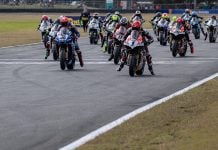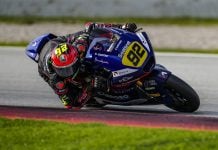FIRST PERSON/OPINION Via e-mail: Maybe DMG will be like “New Coke.” They’ll “redesign” it and go back to old formula. Nah, their egos are probably bigger than Coca Cola, to big to admit failure. Doug Scronce St. Louis, Missouri FIRST PERSON/OPINION Via e-mail: I have been reading all the opinions on the future of AMA road racing and wanted to add my two cents worth. Firstly, my background, I am a fan of road racing, love close racing and have grown tired of watching Spies and Mladin decide who gets first and second every race weekend. It’s not fun to watch. I made the pilgrimage from Toronto to Miller to spectate at the World Superbike races not necessarily to watch the AMA series but rather World Superbike where generally there will be a dog fight to the finish. When I think of Superbike I think of the late ’70s and early ’80s when some of the best racers made their names on bikes that wobbled from turn to turn. Back then the power was too great for the chassis while today the power is too great for the tires. When I think of NASCAR, I think of basic American and Japanese sedans hopped up for the racetrack. Yes the NASCAR sedan on the track is far removed from what I buy at the local dealer but it does build strong brand loyalty. All the major manufacturers are building exciting litre naked bikes. These are bikes that are the best reflection of today’s sedans racing in NASCAR. As the average bike owner ages and begins to look at options beyond a bike with 1 inch of bar rise, their best option is to look at today’s naked. Am I missing something here but could we not solve many problems by going backward to the good old days and differentiate Superbikes from GP bikes like they used to be? I keep reading how the new litre bikes and Ducati 1098R are beyond “road worthy” and should be delivered directly to the local race track. Should Superbikes not be more aligned with what we can ride to work on Monday and take on the road to see a race? Would the racing be closer if aerodynamics were removed and horsepower capped at a reasonable level? Would this make the sport less expensive and less a barrier to entry for others? I also want to respond to David Swarts’ First Person/Opinion with respect to running endurance races during AMA weekends. The one thing that will likely stop me from going to more races is the boredom of waiting around for something to happen. If I am your typical race fan then I want to be entertained. What is so wrong with sending out a troop of riders for an endurance race at the end of the day on Saturday? Maybe it would sell more hamburgers and camping spots for the weekend. Would Woodstock have been such a great success if only three bands had played? Dean Macaskill Toronto, Ontario, Canada FIRST PERSON/OPINION Via e-mail: There is no way a bike could be raced at The Glen without making huge changes. That track is completely surrounded by Armco with very little run-off room anywhere. I attended races at Laconia for 20 years and didn’t shed a tear when the AMA took it off the schedule. I have been to Barber for the last 3 years and enjoy the track, but there are not many places to pass there. Mid-Ohio has several places that don’t leave any room for error and agree that racing there in the rain would not be cool. I have only attended one race in Atlanta and after watching Roger Lee pass DiSalvo in that last turn, decided that Roger Lee really didn’t care much for himself. I have always thought that superbikes should run superstock rules with a spec un-leaded fuel and different tire companies with the same tires available to everyone. Throwing supersport away doesn’t make much sense. I don’t want to see pit stops in motorcycle racing. Take the 200 mile thing from Daytona and run 2 superbike races that weekend and I might go back. I am afraid the we are watching the demise of road racing in this country and I will have to find some other way to amuse myself. At least my wife will be happy, since I won’t have to schedule my vacations around weekends where, as she points out, a bunch of guys start out and finish at the same place for no apparent reason. Don Fraser Warsaw, New York FIRST PERSON/OPINION Via e-mail: I want to weigh in on the DMG Direction debate. Common Goal: First, let’s start with the common goal for spectators, promoters and participants: We all want a “good show.” What makes this possible? In my opinion, at its core, racing is a narrative like any other show on TV or radio, in print, even on the stage. A compelling narrative always includes, to some degree, a vicarious experience enjoyed by the spectators. In fact, recent brain imaging research have found that the same pattern of brain activity is observed in people who are watching an activity is the same as when that person is actually doing it themselves. Anecdotally, I always involuntarily react with a corrective motion and a loud “utterance” whenever a racer I’m watching has a scary moment or a crash. Usually followed by a protest from my wife and a blast of adrenaline to my system. You too, no? Another thing that makes a narrative compelling is the emergence of some kind of insight into the human condition. Example; hard work and sacrifice leads to success but is not guaranteed. Some luck is required, too. Somehow, we never get tired of this one. Close Racing: Yes, close racing is important to keep a spectator on the edge of their seat but its not enough. Some of the closest racing internationally is MotoGP’s 125 class. By DMG logic it should be the “premier class” but most people watch the 800’s and skip the 125s so that logic is flawed. Racing: The objective of racing is to go faster than everyone else. The 800s are much faster than the 125s and that’s why it gets more of our attention. Seems obvious. Vicarious Experience: In fiction, the “believability” of the characters is essential to “suspending disbelief” and leads to the satisfaction of a fully immersive experience. That is, they should be LIKE SOMEONE we know. Ideally, a character will be similar to OURSELVES to get the most of any emerging insight. In racing, the more similar the racing vehicles are to what we or someone we know owns the easier it is to have this vicarious experience. To my thinking, its this aspect that the success of stock car racing own much to. Unfortunately, it also leads to the conclusion that motorcycle racing will never be as popular as stock car racing until more people ride motorcycle than cars. But, in motorcycle racing, the rider is overtly visible and we all have bodies. Everyone can relate to the thrill of speed and victory as well as the pain of a crash. High Stakes: I’ve been riding motorcycles for roughly 30 years against the wishes of my father. He never understood why I would voluntarily expose myself to the risk. It took me a long time to formulate this compelling argument: When you play cards, it’s fun but not as exciting as when you bet your hard earned money. When you are racing motorcycles you raise the stakes to the ultimate: physical harm and possible death. There is nothing more exciting to watch than an exceptional human being evading death through skill and cunning. The Limits of Human Ability: One of the insights provided by completive sports is the demonstration of the limits of human potential. This is a yard stick that we can measure ourselves against. I think its the primary reason that sports is so popular in the world. International sports tell us something about our potential as a species rather than relative to people who live near us. Nationality is just another hook for the vicarious experience and that’s fine but we want to learn about who we are as a whole. Planes Fly Both Ways There was a time when the Daytona 200 attracted the fastest motorcycles and the fastest riders on earth but no more and it lost a lot of appeal. Racing here needs to be comparable to racing world wide for it to be as appealing as possible. If we have a premier class that is sufficiently similar to classes worldwide then it would be possible for the fastest riders in the world could come here to compete. Just look at the AMA/WSBK round held at Miller this year. All Jensen had to do was fit Pirelli tires to qualify as a wild card in the WSBK event. If DMG was successful in raising the purses it might well attract an international contingent of racers. Further, our guys could go over there fairly easily, too. I Can Relate: Ever wonder how fast Mat Mladin would go on your bike? Interesting, no? Racing Improves the Breed: This classic justification for racing is valid but only to the degree it applies to production vehicles made available to the public. The 2 strokes of the 125 and 250 GP classes have little to transfer to production vehicles. Some might argue that it is marginally immoral to develop these small bikes to the limit of our knowledge when high efficiency small motorcycles might be part of a solution to our energy and greenhouse problems. It is important to channel our collective minds to advancing technology that can be transfered to production motorcycles. Having Said That: I’m in general agreement with Dave Arkle’s and David Swarts’ First Person Opinions. The Superstock class is internationally recognized and they are nearly as fast as the Superbikes. FIM Superstock has 5 manufacturers involved in nail-bitingly tight racing. It encourages advancement in production technology that becomes available to everyone very directly, performing a service to the public. Spec tires would be great to keep costs down and would be advantageous to us all if they were DOT approved. Spec fuel is a good idea too as long as its the same as pump gas available to everyone. I’d go one step further and limit the quantity for each race based on a standard miles per gallon figure. The Supersport class enjoys the same advantages except the engines are smaller. As far as the Moto-ST class, I don’t believe in the philosophy of handicapping good performers to benefit poor performers. This defeats the justification for racing. Maybe a better way is to severely reduce the fuel quantities allotted per race and allow any stock motorcycle regardless of displacement or configuration. Who knows, maybe hybrid motorcycles would have a competitive advantage in this class. Adam Oranchak Brooklyn, New York
A Few Reader Comments On The AMA Road Racing Situation, Part IV
A Few Reader Comments On The AMA Road Racing Situation, Part IV
© 2008, Roadracing World Publishing, Inc.






